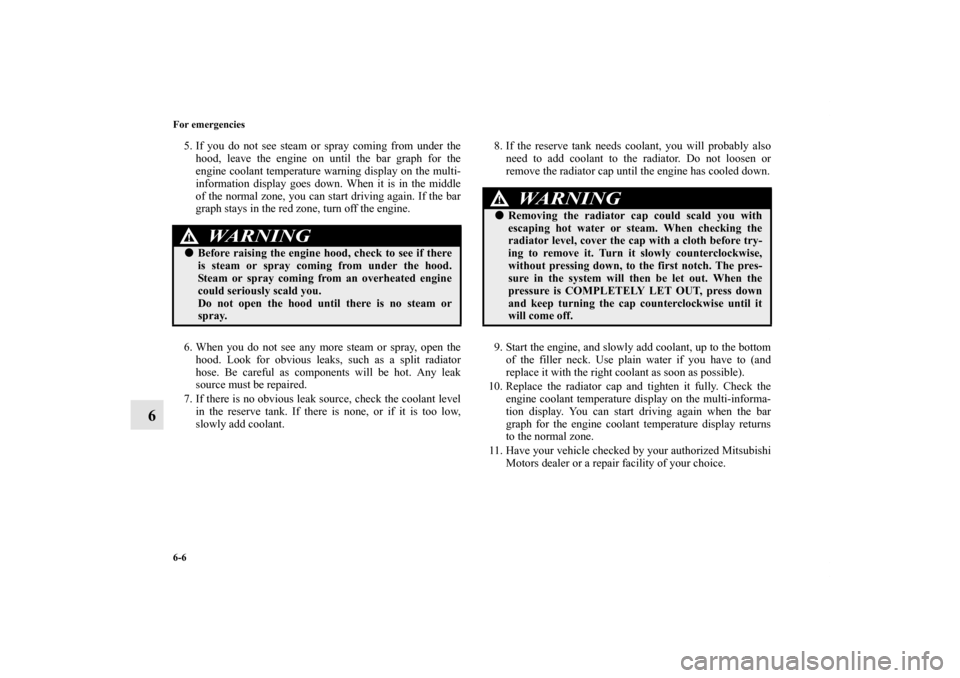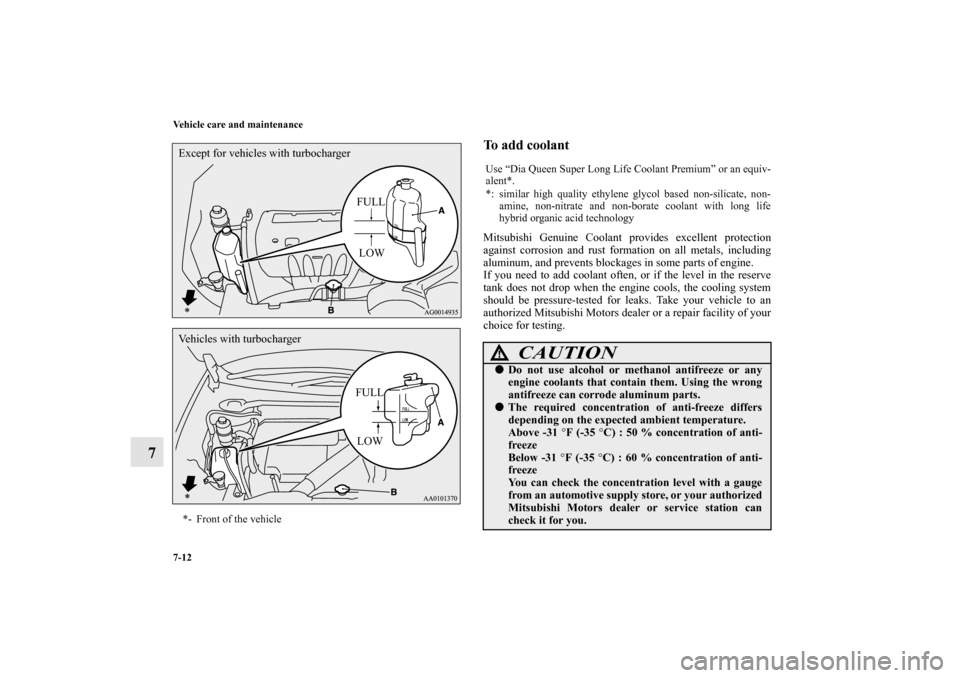Page 401 of 706

4-8 Driving safety
4Loading information
N00629900323
It is very important to know how much weight your vehicle can
carry. This weight is called the vehicle capacity weight and
includes the weight of all occupants, cargo and non-factory-
installed options. The tire and loading information placard
located on the driver’s door sill of your vehicle will show how
much weight it may properly carry.
It is important to familiarize yourself with the following terms
before loading your vehicle:
�Vehicle maximum load on the tire: load on an individual
tire that is determined by distributing to each axle its share
of the maximum loaded vehicle weight and dividing by
two.
�Vehicle normal load on the tire: load on an individual tire
that is determined by distributing to each axle its share of
the curb weight, accessory weight, and normal occupant
weight and dividing by two.
�Maximum loaded vehicle weight: the sum of -
(a) Curb weight;
(b) Accessory weight;
(c) Vehicle capacity weight; and
(d) Production options weight.�Curb weight: the weight of a motor vehicle with standard
equipment including the maximum capacity of fuel, oil,
and coolant.
�Accessory weight: the combined weight (in excess of
those standard items which may be replaced) of automatic
transmission, power steering, power brakes, power win-
dows, power seats, radio, and heater, to the extent that
these items are available as factory- installed equipment
(whether installed or not).
�Vehicle capacity weight: the rated cargo and luggage load
plus 150 lbs (68 kg)* times the vehicle’s designated seat-
ing capacity.
�Production options weight: the combined weight of those
installed regular production options weighing over 5 lbs
(2.3 kg) in excess of those standard items which they
replace, not previously considered in curb weight or
accessory weight, including heavy duty brakes, ride level-
ers, roof rack, heavy duty battery, and special trim.
�Normal occupant weight: 150 lbs (68 kg)* times the num-
ber of specified occupants. (In your vehicle the number is
3)
�Occupant distribution: distribution of occupants in a vehi-
cle as specified. (In your vehicle the distribution is 2 in
front, 1 in second row seat)
WA R N I N G
!�Never overload your vehicle. Overloading can dam-
age your vehicle, adversely affect vehicle perfor-
mance, including handling and braking, cause tire
failure, and result in an accident.
*: 150 lbs (68 kg) is the weight of one person as defined by
U.S.A. and Canadian regulations.
BK0125300US.book 8 ページ 2010年5月18日 火曜日 午後1時53分
Page 561 of 706

6-6 For emergencies
6
5. If you do not see steam or spray coming from under the
hood, leave the engine on until the bar graph for the
engine coolant temperature warning display on the multi-
information display goes down. When it is in the middle
of the normal zone, you can start driving again. If the bar
graph stays in the red zone, turn off the engine.
6. When you do not see any more steam or spray, open the
hood. Look for obvious leaks, such as a split radiator
hose. Be careful as components will be hot. Any leak
source must be repaired.
7. If there is no obvious leak source, check the coolant level
in the reserve tank. If there is none, or if it is too low,
slowly add coolant.8. If the reserve tank needs coolant, you will probably also
need to add coolant to the radiator. Do not loosen or
remove the radiator cap until the engine has cooled down.
9. Start the engine, and slowly add coolant, up to the bottom
of the filler neck. Use plain water if you have to (and
replace it with the right coolant as soon as possible).
10. Replace the radiator cap and tighten it fully. Check the
engine coolant temperature display on the multi-informa-
tion display. You can start driving again when the bar
graph for the engine coolant temperature display returns
to the normal zone.
11. Have your vehicle checked by your authorized Mitsubishi
Motors dealer or a repair facility of your choice.
WA R N I N G
!�Before raising the engine hood, check to see if there
is steam or spray coming from under the hood.
Steam or spray coming from an overheated engine
could seriously scald you.
Do not open the hood until there is no steam or
spray.
WA R N I N G
!�Removing the radiator cap could scald you with
escaping hot water or steam. When checking the
radiator level, cover the cap with a cloth before try-
ing to remove it. Turn it slowly counterclockwise,
without pressing down, to the first notch. The pres-
sure in the system will then be let out. When the
pressure is COMPLETELY LET OUT, press down
and keep turning the cap counterclockwise until it
will come off.
BK0125300US.book 6 ページ 2010年5月18日 火曜日 午後1時53分
Page 586 of 706
Vehicle care and maintenance
7-7
7 View of the engine compartment
N00937600654
Except for vehicles with turbocharger
1- Power steering fluid reservoir
2- Air cleaner filter
3- Brake fluid/Clutch fluid reservoir (if so equipped)
4- Engine coolant reservoir
5- Windshield washer fluid reservoir
6- Engine oil level dipstick
7- Radiator cap
8- Engine oil filler cap
9- Battery Vehicles with turbocharger
BK0125300US.book 7 ページ 2010年5月18日 火曜日 午後1時53分
Page 590 of 706
Vehicle care and maintenance
7-11
7
To replace the oil filter
N00955100055
The oil filter should be replaced at the time or mileage speci-
fied in the “WARRANTY AND MAINTENANCE MAN-
UAL”.
Only use high quality replacement filters on this vehicle. The
manufacturer’s specifications for Genuine Mitsubishi oil filters
require that the filter can withstand a pressure of 256 psi
(1.8 MPa). A Genuine Mitsubishi oil filter is the best replace-
ment filter.
Follow the installation instructions printed on the filter.
Engine coolant
N00937800513
To check the coolant level The coolant reserve tank (A) lets you quickly see when you
need to add coolant. When the engine is cold, the level in the
reserve tank should be between the “FULL” and “LOW”
marks. The radiator usually stays full so there is no reason to
remove the radiator cap (B) except when you check the coolant
freeze point or replace the antifreeze coolant.
BK0125300US.book 11 ページ 2010年5月18日 火曜日 午後1時53分
Page 591 of 706

7-12 Vehicle care and maintenance
7
To add coolant Mitsubishi Genuine Coolant provides excellent protection
against corrosion and rust formation on all metals, including
aluminum, and prevents blockages in some parts of engine.
If you need to add coolant often, or if the level in the reserve
tank does not drop when the engine cools, the cooling system
should be pressure-tested for leaks. Take your vehicle to an
authorized Mitsubishi Motors dealer or a repair facility of your
choice for testing.
*- Front of the vehicle
FULL
LOW Except for vehicles with turbocharger
Vehicles with turbocharger
FULL
LOW
Use “Dia Queen Super Long Life Coolant Premium” or an equiv-
alent*.
*: similar high quality ethylene glycol based non-silicate, non-
amine, non-nitrate and non-borate coolant with long life
hybrid organic acid technology
CAUTION
!�Do not use alcohol or methanol antifreeze or any
engine coolants that contain them. Using the wrong
antifreeze can corrode aluminum parts. �The required concentration of anti-freeze differs
depending on the expected ambient temperature.
Above -31 °F (-35 °C) : 50 % concentration of anti-
freeze
Below -31 °F (-35 °C) : 60 % concentration of anti-
freeze
You can check the concentration level with a gauge
from an automotive supply store, or your authorized
Mitsubishi Motors dealer or service station can
check it for you.
BK0125300US.book 12 ページ 2010年5月18日 火曜日 午後1時53分